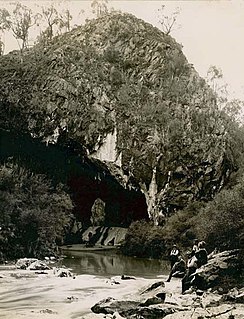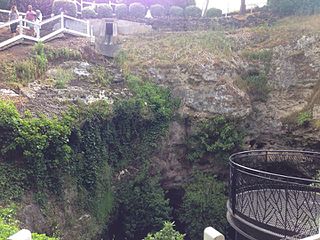 W
WThe Abercrombie Caves, contained within the Abercrombie Karst Conservation Reserve, are a series of limestone arch caves that are located in the Central West region of New South Wales, Australia. The caves are renowned for their karst qualities, namely the formation that has been eroded by water action that has developed from a sinkhole to become a blind valley. Several good examples of crayback formations exist in both entrances.
 W
WBlanche Cave, previously known as "The Big Cave", "The Old Cave" and "Mosquito Plains Cave", is one of 26 caves to be found in the Naracoorte Caves National Park, a World Heritage listed site. Blanche Cave was the first of the caves to be discovered in the Naracoorte area, having been discovered by the European settlers in 1845, and can be accessed by the public through guided tours of the site. The cave contains a number of features, including, at one time, the mummified remains of an indigenous man – remains that were stolen twice in 1861 and never returned. The location has been the site for a number of events, such as, in the early days, annual New Years parties and, much more recently, it was featured as part of the Olympic torch relay for the 2000 Summer Olympics in Sydney. Blanche Cave, along with the nearby Victoria Fossil Cave, was added to the South Australian Heritage Register in 1984.
 W
WThe Buchan Caves are a group of limestone caves that include the Royal Cave and the Fairy Cave, located south-west of Buchan, in the East Gippsland region of the Australian state of Victoria. They have a total length of between 3 and 4 kilometres, and six entrances.
 W
WCapricorn Caves are located 23 kilometres (14 mi) north of Rockhampton, Queensland, Australia. The limestone caves are one of the largest privately owned cave systems in Australia.
 W
WThe Cave Gardens are the garden located in the centre of Mount Gambier in the Australian state of South Australia that contain a 90-ft-deep cave. The cave was initially used as a water source for the town. In 1870 the area became a reserve, and by the 1890s trees, gas lamps and seating were installed in the area. On 2 August 2001, the Cave Gardens were declared a State Heritage area.
 W
WChillagoe-Mungana Caves is a national park in Chillagoe, Shire of Mareeba, Queensland, Australia.
 W
WCutta Cutta Caves Nature Park is a reserve covering 1,499 hectares of limestone Karst landscape near the town of Katherine, in Australia's Northern Territory. The park is easily accessible from the Stuart Highway, about 27 km (17 mi) south of Katherine, and features two show caves where guided tours are offered to the public, making it a popular tourist attraction. The caves are the only tropical examples in Australia which are open to the public.
 W
WEngelbrecht Cave is a cave system in the Australian state of South Australia consisting of a sinkhole with two major passages located under the Mount Gambier urban area. It is owned by the local government area of City of Mount Gambier and has been developed as a tourism venue. Its dry extent is notable as a show cave while its water-filled extent is notable as two separate cave diving sites.
 W
WGunns Plains Cave is a limestone show cave, near Gunns Plains in the North West of Tasmania, twenty kilometres from Ulverstone.
 W
WThe Hastings Caves State Reserve is the setting of a complex of caves and a natural warm springs located 102 km (63 mi) south of Hobart, Tasmania, Australia. Newdegate Cave, the largest dolomite cave in Australia open to tourists, is a part of the complex. They are located 5 kilometres (3.1 mi) from the nearby Lune River fossil/gem centre and the Ida Bay Railway.
 W
WThe Jenolan Caves are limestone caves located within the Jenolan Karst Conservation Reserve in the Central Tablelands region, west of the Blue Mountains, in Jenolan, Oberon Council, New South Wales, in eastern Australia. The caves and 3,083-hectare (7,620-acre) reserve are situated approximately 175 kilometres (109 mi) west of Sydney, 20 kilometres (12 mi) east of Oberon and 30 kilometres (19 mi) west of Katoomba.
 W
WMammoth Cave is a large limestone cave 21 km (13 mi) south of the town of Margaret River in south-western Western Australia, and about 300 km (190 mi) south of Perth. It lies within the Leeuwin-Naturaliste National Park and is surrounded by Karri and Marri forest. It has also had extinct animal fossils found in Mammoth Cave.
 W
WNaracoorte Caves National Park is a national park near Naracoorte in the Limestone Coast tourism region in the south-east of South Australia (Australia). It was officially recognised in 1994 for its extensive fossil record when the site was inscribed on the World Heritage List, along with Riversleigh. The park preserves 6 km² of remnant vegetation, with 26 caves contained within the 3.05 km² World Heritage Area. Out of the 28 known caves in the park, only four are open to the public. Other caves are kept away from the public eye as they are important for scientific research and also for the protection of the caves and their contents. Many of the caves contain spectacular stalactites and stalagmites.
 W
WNgilgi Cave, previously known as Yallingup Cave, is a karst cave to the northeast of Yallingup, in the southwest of Western Australia.
 W
WThe Princess Margaret Rose Cave is a limestone cave located in Lower Glenelg National Park in Victoria, Australia. The cave features actively growing stalactites, stalagmites and helictites. It is arguably the most decorated cave per square metre in Australia. It is named after Princess Margaret.
 W
WThe Wellington Caves are a group of limestone caves located 8 kilometres (5.0 mi) south of Wellington, New South Wales, Australia.
 W
WThe Wombeyan Caves are caves that have formed in marble, in the Wombeyan Karst Conservation Reserve, New South Wales, Australia. Wombeyan Caves is a tourist attraction and local holiday area, as well as a reserve for endangered species, such as several species of wallaby, bird, possum, and wombat.
 W
WThe Yarrangobilly Caves are located in a 12-km-long karst region along the Yarrangobilly River valley in the north of Kosciuszko National Park, New South Wales, Australia. Discovered to British colonists by a cattleman, the Yarrangobilly Caves system includes several independent limestone caves formed over different time periods, from several million to a few hundred thousand years old. The older examples are in higher strata and have more speleothem decoration.